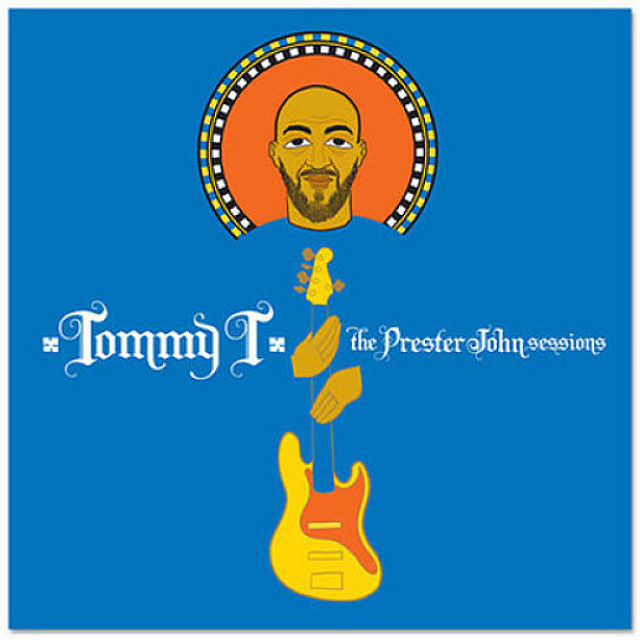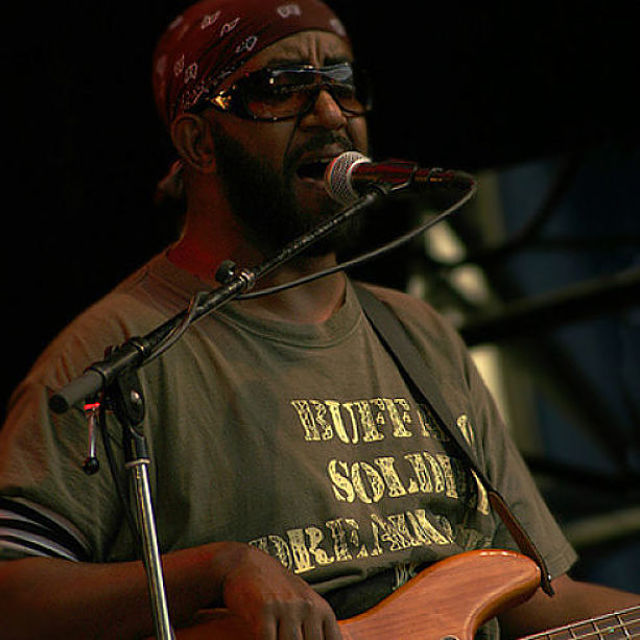Tadias Magazine
By Ayele Bekerie, PhD
Published: Monday, November 23, 2009
New York (TADIAS) – Prester John Sessions is the title of the first solo album of Tommy T Gobena, a talented and innovative global musician, who, I believe, is succeeding in his attempt to grasp the meanings of his diasporic sojourn vis a vis his Ethiopian roots. This article is inspired by the title of his album and is written to express my solidarity with his visions and dreams. The essay attempts to construct a historical narrative of what Ethiopian historians call the Zagwe Dynasty and the Medieval Hatse (King of Kings or Emperors) States, for they were two significant historical periods that are not only directly connected to the legend of Prester John, but they are remarkably endowed with religious tales and accomplishments. It is my contention that these two periods might help us understand the historical dimension of what Tommy T calls ‘Prester John Sessions.’
In his interview with Tseday Alehegn of Tadias Magazine, Tommy cites Graham Hancock’s The Sign and the Seal as a source for the title of his album. In Hancock’s book, he learned about a legendary and powerful Ethiopian king named Prester John, who was sought as an ally by European rulers of the medieval period. Europeans persistently sought the king with the hope of establishing an alliance against Moslem forces who occupied Jerusalem. The strong global sentiment for the legendary Ethiopian king became a source of inspiration to Tommy T, who used the name as a title of his album. In so doing, Tommy T has elevated his artistry by composing music linked to medieval Ethiopian history.
Who is Prester John? According to John Reader, “the earliest-known reference to Presbyter Iohannes (medieval Latin, meaning Prester, or Priest John) appears in an 1145 CE manuscript of Otto, Bishop of Freisingen, referring to him as a powerful Christian priest-king ruling a vast empire vaguely supposed to be somewhere in middle Asia.” The priest-king is equivalent to Hatse of Ethiopia or Pharaoh of ancient Egypt or Kandake of Meroé. It is a collective term that is assigned to divined rulers. Kandake was the title for women rulers of Meroé in the present day Sudan.
Ethiopia of the medieval period often designated geographically as a part of ‘Indies.’ Munro-Hay cites what he calls “the mediaeval planispheres and portulans” who identified Ethiopia as the “Indian land of rumor and legend.”
The earliest reference to Prester John corresponds in the Ethiopian chronology to the period of the Zagwe Dynasty (1137-1270 CE), a dynasty that thrived in Lasta, northern Ethiopia and its seminal achievement, the rock-hewn Lalibela churches, is now recognized as a UNESCO world heritage site, which means that the churches are internationally protected and preserved so that successive generations would be able to enjoy the marvels of architectural feat. The kings of the Zagwe Dynasty presided over an excavation of eleven churches from a single rock. These churches were carved in the twelfth century and they are still in use for mass and other religious activities. In other words, the churches are an enduring expression of devotion to faith and a constant source of global fame.
The kings of the dynasty built churches in Lasta so that Jerusalem continues to live. In fact, the eleven rock-hewn churches built in Lasta are called the churches of the second Jerusalem. The dynasty’s achievement has reached Europe. In fact, they have contributed to the invention and perpetuation of the legend of Prester John.
On the other hand, some historians trace the name Prester John to one of the kings of the Maji. Jasper, one of the kings, is known as Prester John and all his successors assumed the title thereafter. According to this account, the title Prester was chosen “because there was no degree in the world more elevated than the priesthood. The name John was selected in reference to John the Baptist or John the Evangelist,” writes Munro-Hay, citing the story in the Book of the Three Kings (the Maji).
Furthermore, a map published by Sebastian Munster at Basle in 1544 locates the kingdom of Prester John in the northern highlands of present day Ethiopia. Prester John is also mentioned in maps drawn in an earlier period, such as the Egyptus Novelo map of Florence (1454) and the Mappomondo of Venice (1460). This particular period corresponds to the period of the ‘restored’ Solomonic Dynasty. It is also known as Shoan Dynasty. This period has produced great Ethiopian emperors, such as Hatse Yekuno Amlak (1270-1285), Hatse Amda Tsion (1314-1344), Hatse Dawit I (1382-1413), Hatse Yishaq (1414-1429), Hatse Zer’a Ya’qob (1434-1468), Hatse Libne Dengel (1508-1540), and Hatse Tserse Dingel (1563-1597). The Dynasty, which was founded by Hatse Yikno Amlak in 1270 in Shoa, the central highlands of Ethiopia, had 26 Hatses and lasted for 302 years. According to Tadesse Tamrat, “the borders of this kingdom extended roughly to the northern districts of Shoa in the south, the region east of Lake Tana and the upper Blue Nile in the west, and the edge of the Ethiopian plateau in the east.”
The Hatses are divined and their power is defined in the Fetha Nagast, or Law of the Kings. Their power is both ecclesiastical and civic. Kebra Nagast, or the Glory of Kings, on the other hand, is a sacred text linking the genealogy of the Hatses to Menelik I, the founder of the Solomonic Dynasty.
In the period of the ‘restored’ Solomonic Dynasty, “there were also Muslim principalities in the area, along the coast from the Dahlak archipelago in the Red Sea to the Somali town of Brava on the Indian Ocean.” The Muslim principalities were strategically located and benefited a great deal by controlling trade routes in the region. Tadesse observes that “by the end of the thirteenth century, powerful Muslim communities had emerged which were to constitute various well-organized principalities and states: the most important in the interior were Shoa, Ifat, Fetegar, Dawaro, Hadya, Bali and Adal.”
The Sultans of Muslim communities entered in both peaceful and hostile relations with the Hatses of the Ethiopian plateau. During the medieval period, they managed to maintain their autonomy, even though most of them were obliged to pay tributes to the Hatses. Some of the Hatses chose peaceful coexistence with Muslim principalities, while others used force to convert the Muslims to Christianity. In the sixteenth century, a rebellious Muslim leader emerged and succeeded in conquering vast regions controlled by Hatses. The Muslim leader was Imam Ahmed, who defeated the army of Hatse Lebne Dengel at the Battle of Shimbra Qure.
According to Ayele Teklehaymanot, ‘love for things Ethiopian’ began in Europe in the middle Ages. Europe desperately searched for the legendary Pester John in the Indies, which was a geographical term of the time that refers to eastern Ethiopia (India and the Arabian Peninsula) and western Ethiopia (the Horn of Africa, and north east Africa). The Europeans were desperate in their desire to wrest back Jerusalem from Jihadist occupiers. It is also important to note that the geographical interpretation of Indies also placed Ethiopia in Asia. For instance, Honorius D’Autumn, at the beginning of the XII Century CE, asserts: “Sunt vero termini Africae: nilus ex parte orientis…” To Giovanni Battista Brocchi of the fifteenth century CE, the subjects of the ‘Prester John’ were distinguished as Ethiopians and Indians.
“In the year 1400 King Henry IV of England sent a letter to the ‘King of Abyssinia, Prester John.” Tadesse Tamrat, the eminent Ethiopian historian and author of the definitive book, Church and State in Ethiopia (1972), identified the Ethiopian king for whom the letter addressed to as Atse Dawit, the father of the famous and learned emperor Hatse Zer’a Ya’qob, who authored several sacred books. Historians are not certain whether the letter reached Hatse Dawit. However, a copy of the letter is found in the British Royal archives. Portuguese and Roman writers of the middle Ages translated Hatse to mean priest-king.
The genesis of Prester John, as I indicated earlier, coincides with the period in Ethiopian history that may be characterized by a great deal of religious revivalism. This period includes the Zagwe Dynasty of Lasta and the ‘restored’ Solomonic Dynasty of the central Ethiopian highlands. Temporally, the period extends from eleventh century to the sixteenth century of the Common Era. During this time, the Ethiopian rulers were directly involved in the teachings, writings and administration of the Orthodox Tewahedo Church.
It is also important to note that the period was a period of the consolidation of Islamic states and sultanates. One might add that it was also towards this period that history recorded the internal turmoil that resulted in the rearrangement of the region with irreversible settlement of the Oromos on the central and northern highlands of Ethiopia. Their concept of Gudficha made it easier for diverse ethnic groups on the highlands to interact with the Oromos. Islamic states have also expanded beyond the traditional borderlands and lowlands of the country.
The Late Stuart Munro-Hay in his book Ethiopia Unveiled: Interaction Between Two Worlds, extensively documented the meeting of Europe and ‘Prester John.’ According to Munro-Hay, in 1427 the ‘Prester John’ sent two ambassadors, one Muslim and one Christian, to Valencia to see Alfonso V, king of Aragon (Spain). ‘Prester John’ Yeshaq or Hatse Yeshaq ruled an empire that had seventy-two kings; twelve were Muslims and the rest Christian. What is notable about this account is that ‘Prester John’ appeared to have succeeded in presiding over both Muslim and Christian states. His decision to send Muslim and Christian emissaries to Aragon may suggest the prevalence of peaceful co-existence of Muslims and Christians in Ethiopia. ‘Prester John’ did not participate in the ‘crusade’ to liberate Jerusalem, perhaps unwilling to disrupt the peace he established in his multi-religious empire.
King of Aragon’s envoy to Ethiopia carried with him a letter dated 15 May 1428 to “the most eminent and most victorious monarch, the lord Ysach [Yeshaq], son of David, by the Grace of God, Presbiter Johannes of the Indies, master of the Tablets of Mount Sinay and the Throne of David, and king of kings of Ethiopia.” The letter, which is still available at the Aragon Archive in Barcelona, Spain, hints at that time a strong Ethiopia whose leader was victorious and who also, sought trade and diplomatic relations with Europe. Hatse Yeshaq even suggested marriage alliances with the Aragon royal family. It might be worthwhile to note that the earliest written reference to Somalia is found in a praise poem written in Amharic for Hatse Yeshaq, whose empire reached the northern Somali coast.
Several Arab historians and geographers profusely documented the history of the Hatse Medieval States, apart from local large historical documents and royal chronicles, their deeds. The Arab historians narrated in greater details the powers and territories of both the Hatses and the Sultanates. We also learn that the Hatses sent emissaries and letters to Europe in order to establish diplomatic and trade relations. The Hatses have fought with the Muslim states and often settle their political disputes by acknowledging their relative power position.
Ibn Yaqub in 872 wrote about the Hatses’ control over the Dahlak islands on the Red Sea. Masudi in 935 reported that Hatses controlled the port of Zeyla in the Gulf of Aden, as well as the Dahlak Islands on the Red Sea. Ibn Hawkal in 970 agreed with the reporting of Masudi.
The geographer Idris included northern Somalia as part of the sovereign of the Hatses. Another Geographer Ibn Said in the thirteenth century identified the Wabe Shebele River as a divider between the territories of Ethiopia and Azania. According to Ibn Said, the northern half of Moqadishu was under the rule of the Hatses. Ibn Fadal Alah Omari in the fourteenth century wrote about the vast empire of the Hatses. The territory extends from Indian Ocean to Gulf of Aden to Barka Valley of northern Eritrea. The fourteenth century Ethiopia had ninety-nine big and small states governed by kings and sultanates. These states paid their tributes to Hatses or king of kings of Ethiopia.
The Arab historian Omari included the following states under the sovereign of Hatses: Somhar, Hamasien, Nara, Tigrai, Sehart, Amhara, Shoa, Damot, Genz, Adasso and Mora. The South Eastern territories have also paid tributes to the Hatses. These territories were: Yifat, Dewaro, Arababani, Hadiya, Sharka, Bale and Derra. These historians have also documented the presence of fifty linguistic groups within Medieval Ethiopia.
Historians also researched the accounts of Portuguese travelers. Some even suggest that the legend of Prester John inspired the Portuguese to build ships and navigate the oceans. Given the fact that the Portuguese travelers were among the first foreign visitors received by the Hatses, it was clear that they took the legend very seriously. For instance, Francisco Alvares, who visited Ethiopia for six years at the time of Hatse Lebna Dengel’s rule, referred to him as Prester.
Among the Hatses, Amde Tsion was regarded by far the most powerful. He ruled over both the Christian and Muslim states. The Aragonese king Alfonso V noted in his letter dated 18 September 1450 identified Hatse Zer’a Ya’qob as the ‘most illustrious and most serene prince Lord Jacobo, son of David, of the House of Solomon, Emperor of Ethiopia.’ According to Mersea Hazen Wolde Qirqos, Hatse Zer’a Ya’qob was highly educated. He sponsored the translation of several sacred books from Arabic to Ge’ez. He also authored several holy books himself. According to Richard Pankhurst, “Imperial power was probably at its greatest during the time of the great centralizing emperor Zar’a Ya’qob (1434-68).
It is worthwhile to note that the Medieval Hatse rulers have established governance over the multi-ethnic and multi-religious nation-state. It can be argued that the seeds for modern state of Ethiopia may have been sown much earlier than what is usually believed. Tommy T’s ‘Prester John Sessions’ is a glaring reminder of our persistent quest in our long history, for transforming a shared time and space into one Ethiopia.
—–
This article is well-referenced and those who seek the references should contact Professor Ayele Bekerie directly at: abekerie@gmail.com




